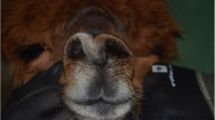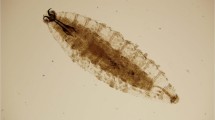Abstract
Nasal myiasis is rare in the world, but India being a tropical country the disease is very common and extremely demoralising for the patients. Keeping this in view, the clinical profile of nasal myiasis with special reference to entomological aspects was studied in 13 cases from February 1991 to March 1992. It was found to be common in age group 61– 70 yrs (38.5%). Foetor, maggots in the nose, blood stained nasal discharge, necrotic material and atrophic turbninates were seen in all cames. The major complications were maxillary sinusitis found in all the cases and diffuse cellulitis of face in 69.2% cases. Penetration of fly into the nasal cavity was recalled by 38.4% cases. Treatment consisted of removing the maggots manually after turpentine nasal douche. Larvae were cultured on fresh placenta/tonsil in 8 cases. The fly causing myiasis in this area was identified as chrysomyia bezziana. Use of mosquito net and treatment of the cause was found to be the most effective and easy method of prevention.
Similar content being viewed by others
References
Gadre, K.C., Bhargave, K.B., Pradhan, R.Y., Lodaya, J.D., Ingle, M.V. (1971): Closure of the nostrils (Young’s operation) in atrophic rhinitis. Journal of Laryngology Otology 85: 711–714.
Patton, W.S. (1921): Some notes on Indian Calliphorinae. Indian Journal of Medical Research 9: 642–653.
Rieley, S.D., Howlett (1914): Myiasis. Indian Medical Gazette 49 : 8.
Sabde, M. (1987): Atrophic rhinitis. Treatment by placental grafts. Thesis for M.S. (ENT), Nagpur University, Nagpur.
Sahay, L.K. (1959): A study of maggots and their otolaryngeal manifestations. Indian Journal of Otolaryngology 11 : 146–168.
Sharma, H., Dayal, D., Agarwal, S.P. (1989): Nasal myiasis — Review of 10 years experience. Journal of Laryngology Otology 103(5) : 489–491.
Shinton, J.A. (1921): Some cases of myiasis in India and Persia with description of the larvae causing the lesion. Indian Medical Gazette 64 : 380–383.
Singh, I. (1989): Clinicopathological profile of atrophic rhinitis and the role of intranasal placentex therapy. A thesis for M.S. (ENT), Nagpur University, Nagpur.
Singh, I., Raizada, R.M., Chaturvedi, V.N., Jain, S.K.T., (1991): Nasal myiasis in atrophic rhinitis. The Indian Practitioner 44(5) : 343–345.
Sood, V.P., Kakkar, P.K., Wattal, B.L. (1976): Myiasis in otorhinolaryngology with entomological aspects. Journal of Laryngology Otology. 90 : 393–399.
Author information
Authors and Affiliations
Rights and permissions
About this article
Cite this article
Amreliwala, M.S., Jain, S.K.T., Raizada, R.M. et al. Nasal myiasis. IJO & HNS 48, 25–28 (1996). https://doi.org/10.1007/BF03048023
Issue Date:
DOI: https://doi.org/10.1007/BF03048023




